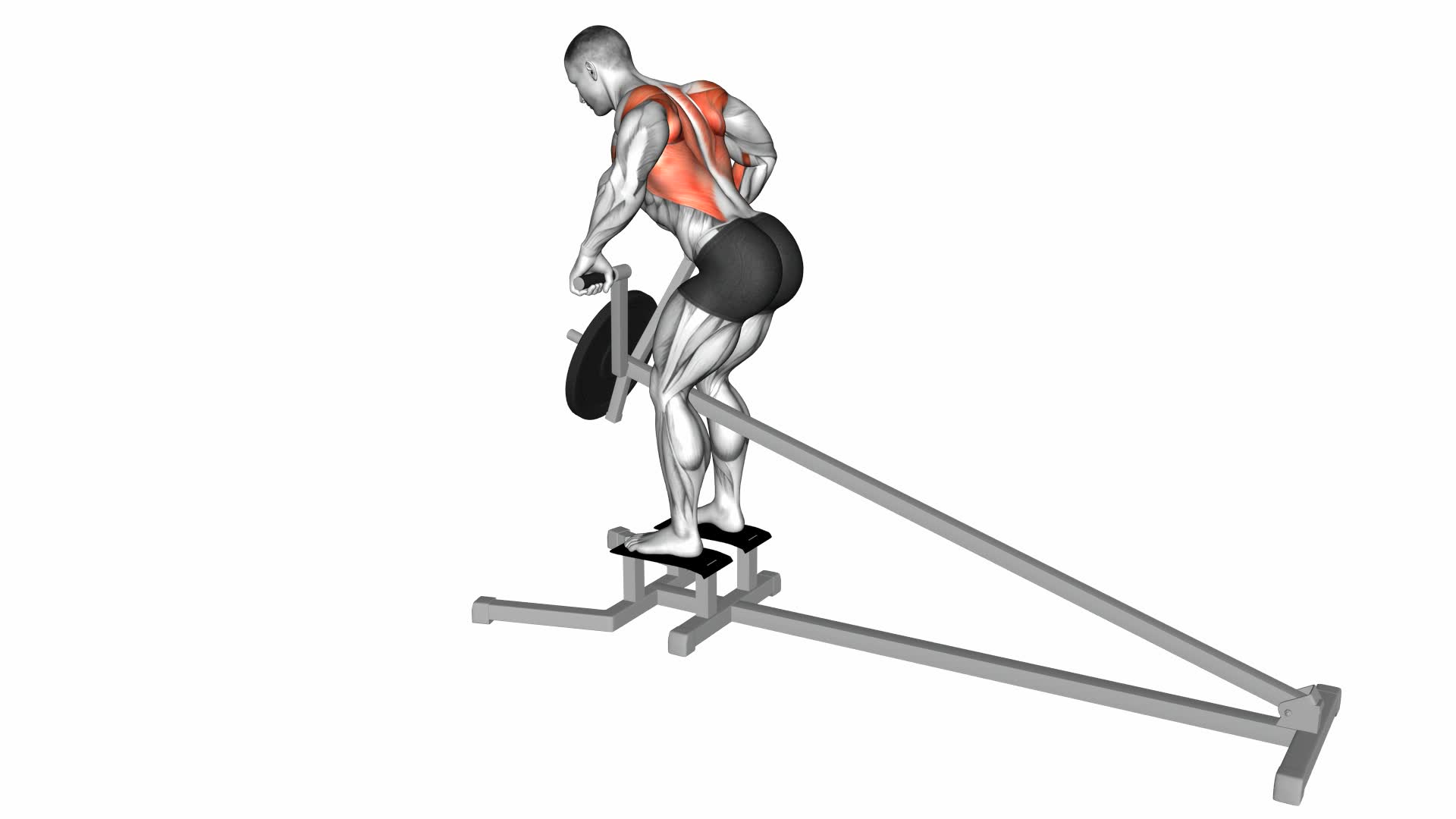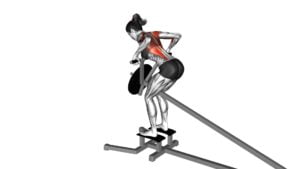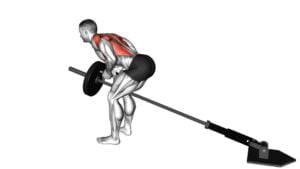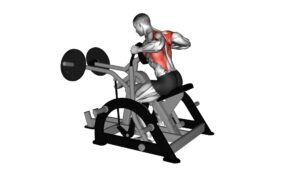Lever T-Bar Row (Plate Loaded) – Video Exercise Guide & Tips

Are you looking for an effective back exercise that targets multiple muscles? Look no further than the Lever T-Bar Row!
Watch This Exercise Video
In this video exercise guide, we'll show you how to properly perform this plate loaded exercise for maximum results. Whether you're a beginner or advanced fitness enthusiast, we've got you covered with variations and modifications.
Avoid common mistakes and get ready to strengthen and tone your back muscles like never before. Let's get started!
Key Takeaways
- The lever T-bar row targets multiple muscles in the upper back.
- It improves posture, upper body strength, and overall muscular balance and stability.
- The exercise engages multiple muscle groups, including the biceps, forearms, and core.
- It offers a safe and controlled range of motion and can be modified to target specific muscle groups.
Benefits of the Lever T-Bar Row
The Lever T-Bar Row offers several benefits for building strength and muscle in your upper back. One of the main benefits of this exercise is the targeted muscle activation it provides. When performing the Lever T-Bar Row, your upper back muscles, including the rhomboids, trapezius, and latissimus dorsi, are heavily engaged. This means that you can effectively strengthen and develop these muscles, leading to improved posture and overall upper body strength.
Additionally, the Lever T-Bar Row allows for a greater range of motion compared to other back exercises. This increased range of motion not only helps to target different muscle fibers but also allows for a more complete contraction of the back muscles. As a result, you can achieve more muscle growth and development.
Furthermore, the Lever T-Bar Row is a compound exercise, meaning it works multiple muscle groups at the same time. Along with the upper back muscles, this exercise also engages the biceps, forearms, and even the core muscles. This comprehensive muscle activation not only helps to build strength but also improves overall muscular balance and stability.
Equipment and Set-Up for the Exercise
To properly set up for the Lever T-Bar Row exercise, you'll need a barbell and a T-bar row machine. Here's how you can set up the equipment and get ready for the exercise:
- Position the T-bar row machine in a stable and secure location.
- Load the desired weight plates onto the machine's weight pegs.
- Place a barbell into the T-bar row machine's sleeve, ensuring that it's securely fastened.
- Adjust the footplate height to match your desired starting position.
- Stand facing the T-bar row machine, with your feet shoulder-width apart and knees slightly bent.
By following these steps, you'll have the necessary equipment and a properly set up T-bar row machine to perform the Lever T-Bar Row exercise.
Remember to always check that the equipment is secure and stable before starting your workout. This will help ensure your safety and allow you to focus on performing the exercise effectively.
Proper Form and Technique for the Lever T-Bar Row
To perform the Lever T-Bar Row exercise with proper form and technique, focus on engaging your back muscles and maintaining a stable position throughout the movement. This exercise primarily targets the latissimus dorsi, rhomboids, and rear deltoids, activating these muscles to promote strength and development.
To begin, position yourself in front of the lever t-bar row machine. Place your feet shoulder-width apart, knees slightly bent, and grasp the handles with an overhand grip. Keep your back straight and core engaged throughout the exercise.
Initiate the movement by retracting your shoulder blades and pulling the handles towards your chest. Focus on squeezing your back muscles as you perform the rowing motion. Keep your elbows close to your body and avoid using momentum to lift the weight.
To fully engage your back muscles, pause for a moment at the top of the movement, and then slowly lower the weight back to the starting position, maintaining control throughout.
To incorporate the lever t-bar row into a full body workout routine, consider pairing it with exercises that target other muscle groups. For example, you can combine it with exercises like squats, bench presses, and shoulder presses to create a comprehensive upper and lower body workout.
Remember to always prioritize proper form and technique to maximize the benefits of this exercise and minimize the risk of injury.
Variations and Modifications for Different Fitness Levels
For different fitness levels, you can modify the lever t-bar row exercise by adjusting the weight load or using different grip variations. Here are some progression options and muscle groups targeted:
- Increase or decrease the weight load: As you become stronger, you can gradually increase the weight load to challenge your muscles and promote muscle growth. Conversely, if you're a beginner or recovering from an injury, you can start with lighter weights and gradually increase the load as your strength improves.
- Use different grip variations: Changing your grip can target different muscles and add variety to your workout. For example, using an underhand grip targets your biceps more intensively, while an overhand grip predominantly works your back muscles. Experiment with different grip positions to find what works best for you.
- Single-arm lever t-bar row: Performing the exercise with one arm at a time can help improve stability and isolate each side of your back muscles. This variation can be beneficial for individuals who've imbalances or asymmetries in their back strength.
- Wide grip lever t-bar row: By using a wider grip, you can target your outer back muscles, such as the latissimus dorsi, more effectively.
- Close grip lever t-bar row: Bringing your hands closer together on the bar engages your inner back muscles, such as the rhomboids and middle trapezius.
Common Mistakes to Avoid When Performing the Lever T-Bar Row
To avoid common mistakes when performing the lever T-Bar Row, ensure that you maintain proper form and technique throughout the exercise. This won't only help you maximize muscle activation but also minimize the risk of injuries.
One common mistake to avoid is rounding your back during the movement. This puts excessive stress on your spine and can lead to back pain or injury. Instead, keep your back straight and engage your core muscles to maintain stability.
Another mistake to avoid is using too much momentum. It's important to control the movement and focus on the muscles you're targeting. Avoid swinging your body or using your legs to generate momentum. Instead, pull the weight using your back muscles and squeeze your shoulder blades together at the top of the movement.
Additionally, avoid using a grip that's too narrow or too wide. A grip that's too narrow can put excessive strain on your wrists, while a grip that's too wide may limit your range of motion and reduce muscle activation. Find a grip width that allows you to comfortably pull the weight while maintaining proper form.
Frequently Asked Questions
How Many Sets and Reps Should I Do for the Lever T-Bar Row?
For the lever T-bar row, it's important to find the optimal training frequency for you. Start with 3-4 sets of 8-12 reps per workout, and adjust as needed based on your goals and fitness level.
Remember to focus on form and technique to maximize the effectiveness of the exercise. There are also variations and modifications you can try, such as using different grip positions or adding resistance bands.
Experiment and find what works best for you.
Can I Do the Lever T-Bar Row if I Have a Lower Back Injury?
If you have a lower back injury, it's important to be cautious when performing the lever T-bar row exercise. This exercise puts stress on the lower back, so it may not be the best option for you.
However, there are alternative exercises you can try that target the same muscle groups without putting as much strain on your lower back.
It's always a good idea to consult with a healthcare professional or a certified trainer to get specific modifications for the lever T-bar row with a lower back injury.
Is It Necessary to Use a Specific Grip for the Lever T-Bar Row?
When performing the lever t-bar row, it's important to consider the specific grip you use. Different grips offer distinct advantages.
Without the context of the Lever T-Bar Row (Plate Loaded) – Video Exercise Guide & Tips {060612}, it's advised to explore various grips and their benefits. By using a specific grip, you can target different muscle groups and achieve optimal results.
Experiment with different grips to find the one that suits your goals and preferences.
Can I Use Dumbbells Instead of a Barbell for This Exercise?
Yes, you can use dumbbells instead of a barbell for the lever t-bar row. This is known as the dumbbell variation of the exercise. It provides a slightly different stimulus to your muscles and can be a good alternative if you don't have access to a barbell.
However, it's important to maintain proper form and control throughout the movement to maximize the effectiveness of the exercise.
If you're looking for more alternative exercises, there are several options to target the same muscle groups.
What Muscles Does the Lever T-Bar Row Primarily Target?
The Lever T-Bar Row is a great exercise for targeting multiple muscles in your back. It primarily works your latissimus dorsi, rhomboids, and trapezius muscles.
This exercise can be done with various variations, such as using dumbbells instead of a barbell.
The Lever T-Bar Row is beneficial for overall back development as it helps to strengthen and tone your back muscles, improve posture, and increase upper body strength.
Conclusion
The Lever T-Bar Row is an effective exercise for strengthening and toning the back muscles. It can be performed with plate-loaded equipment, providing a challenging workout for individuals of all fitness levels.
By maintaining proper form and technique, you can maximize the benefits of this exercise and avoid common mistakes.
Incorporating variations and modifications can further customize the workout to suit your specific goals and abilities.
Overall, the Lever T-Bar Row is a valuable addition to any fitness routine.

Author
Years ago, the spark of my life’s passion ignited in my mind the moment I stepped into the local gym for the first time. The inaugural bead of perspiration, the initial endeavor, the very first surge of endorphins, and a sense of pride that washed over me post-workout marked the beginning of my deep-seated interest in strength sports, fitness, and sports nutrition. This very curiosity blossomed rapidly into a profound fascination, propelling me to earn a Master’s degree in Physical Education from the Academy of Physical Education in Krakow, followed by a Sports Manager diploma from the Jagiellonian University. My journey of growth led me to gain more specialized qualifications, such as being a certified personal trainer with a focus on sports dietetics, a lifeguard, and an instructor for wellness and corrective gymnastics. Theoretical knowledge paired seamlessly with practical experience, reinforcing my belief that the transformation of individuals under my guidance was also a reflection of my personal growth. This belief holds true even today. Each day, I strive to push the boundaries and explore new realms. These realms gently elevate me to greater heights. The unique combination of passion for my field and the continuous quest for growth fuels my drive to break new ground.







